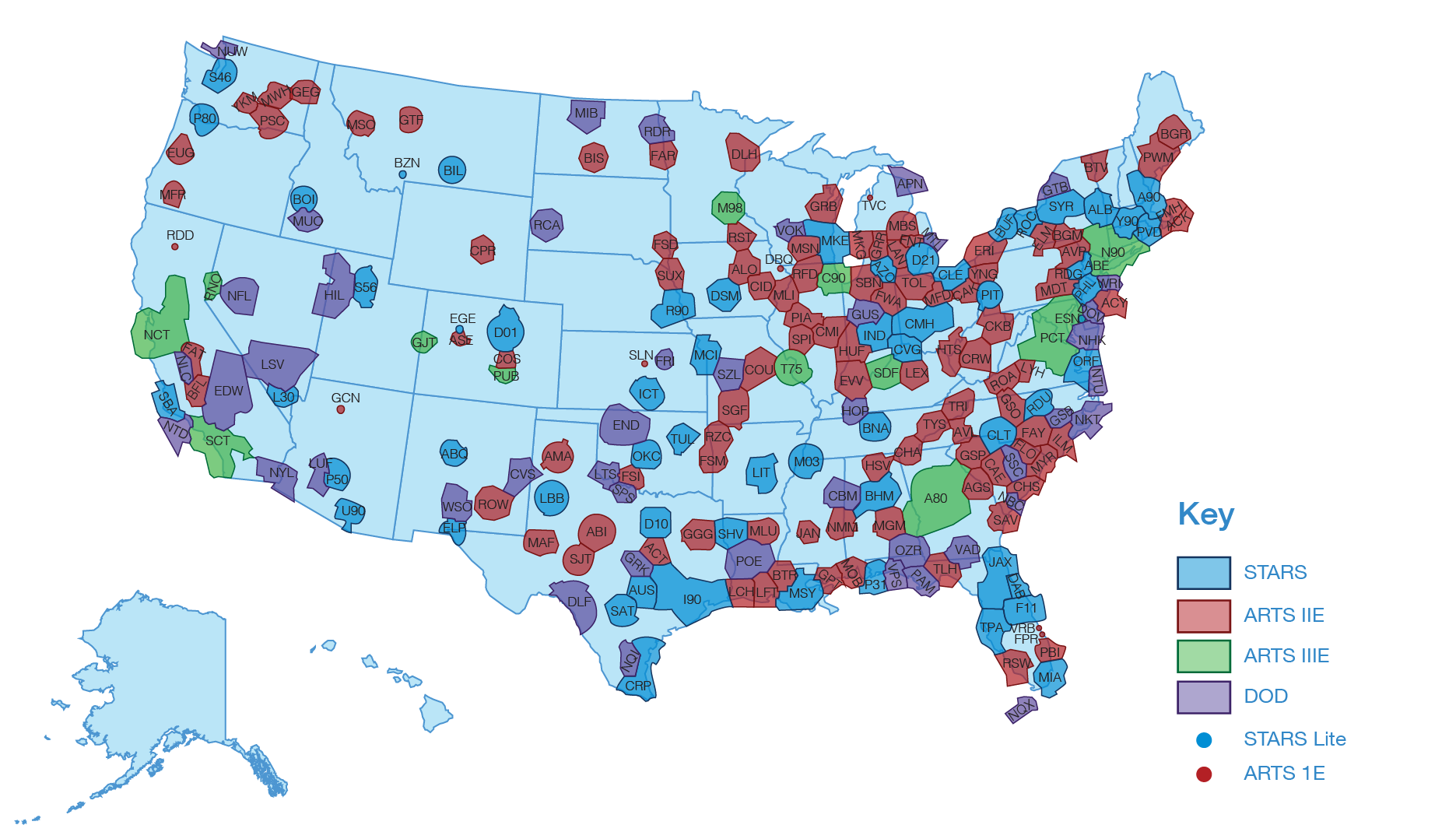It’s a clear sky over San Francisco, with no clouds in sight, and there’s an audible groan as your captain announces that your aircraft’s approach is on hold due to weather conditions. It’s not the pilot, the aircraft, or the airline – there’s a lot more that is going on under the hood of your cross-country trip than what meets the eye. Orbiting somewhere over the Bay Area, you and the 117-foot wide aircraft supporting you are waiting for clearance from the ruler of the airspace you’re inhabiting – the air traffic control tower.
Air traffic control (ATC) towers are an omnipresent feature of modern airports, second in recognition only to airliners themselves. Towers, though, represent only a small part of the vast network that routes aircraft from point to point. Like erstwhile pets, aircraft are shepherded and guided by a variety of different powers as they fly over the United States.
As sophisticated as multimillion-dollar aircraft and massive radar installations are, the manner in which the many layers of controllers ‘bookkeep’ aircraft looks is fairly archaic. A system of plastic strips sorted corresponding to handling order and slotted into a rack, eponymous ‘flight strips’, are, in many ways the backbone of the air traffic control system. Labelled with flight number, destination and routing information, the clacking of these cards in their slots is as ubiquitous as the green radar display screens in front of controllers.
Soon, this is going to change. The Federal Aviation Administration (FAA) is readying the rollout of a new suite of systems called NextGen, which represents the first real integration of 21st century technologies into the air traffic control system.
Multi-tiered system
Civilian Air Traffic domestically is handled at three discrete levels. Control towers at airports handle ground operations, takeoff scheduling, and landing, working to deconflict aircraft approaches and ensure spacing between runway operations. This is just the tip of the iceberg, though – while local towers handle the end-points of a journey, much of the choreography happens well before an airplane even takes off.
Every morning at 6AM Eastern Standard Time, as a part of a nation-wide conference call with the FAA’s David J. Hurley command center in Warrenton, Virginia, airlines file provisional flight plans for domestic and international departures nationwide. Also on the call are regional air traffic control centers, area approach controls, and airport control towers.
As a part of what the FAA calls “traffic flow management,” each commercial aircraft, cargo transport and business jet is carefully placed in a web of air traffic netting over the continent. It’s these flight plans that determine adherence to flight schedules and air operations, and are what determine takeoff order, landing times and routing from point to point.
You would think that the aircraft is flying in a straight line to San Francisco after taking off from John F. Kennedy International, but that’s not the case. Soon after takeoff, aircraft are handed over to what is known as a Terminal Radar Approach Control, which handles ingress and egress of aircraft in a 30-50 nautical mile zone around an airport. Abbreviated to TRACON, 27 of these control centers manage area approaches, deconflicting incoming and outgoing air traffic.
As in the case of New York City’s airspace — which includes JFK, LaGuardia, Newark Liberty, and Philadelphia International — multiple airports clustered together are handled by a single Terminal Control Center. New York City’s Terminal Control Center handles a third of all national air traffic, and a full sixth of all global flights, according to one senior official familiar with the airline industry.

After an aircraft clears a distance ranging between 5 and 40 miles, depending on the airport, from a TRACON or Terminal Control, it is handed over to Air Route Traffic Control Centers. Controlling large swathes of airspace, they handle routing and altitude once an aircraft clears 18,000 feet in altitude, or about when the pilot permits movement and standing in the cabin.
On a typical cross-country journey, an aircraft is handled by 4-5 centers, hopscotching from one to the other before being handed over to the destination airport’s assigned TRACON.

While the prospect of all these routing decisions taking place at once is daunting, it’s important to remember that very few routing choices are made in real time. The aircraft’s flight plan, is passed through the system and into the hands of controllers, who handle routing and scheduling. As someone familiar with the subject explained, pilots only enter data into the system in the event of a reroute or plan change due to weather or other conditions.
A blend of old and new
Introducing and adapting technology for aviation is a process riddled with rigorous safety inspections, assessments, and a complex certification and integration process. This is with good reason, with critical systems needing multiple levels of redundancy and safety before being rated to carry passengers in the air.
Dated information management systems make integration with new technologies difficult, and due to the intense redundancies and testing required for systems managing high-altitude flights upgrades are slow to enact.
Case in point – the replacement system for high-altitude traffic management, (ERAM: En Route Automation Modernization) and its 20 million lines of computer code were only completed in March of this year, and are moving from deployment at the Salt Lake City center to being available at 20 en-route traffic control centers by the end of the year. ERAM is a part of the FAA’s NextGen system, which is an effort involving heavy partnership with the airline industry.

“It [NextGen] requires a cooperative effort between airlines and the FAA to develop and deliver new capabilities,” said a United spokeswoman. “We support any efforts to more quickly implement capabilities that will improve the national airspace system and the flow of air traffic around the country,” she further added.
The tedium that is an innate part of systems integration for technologies used for air travel yields an insight into the very recent introduction of data-based communication into the air traffic control system. Called ‘Data Comm’, the system is analogous to text messaging between aircraft and controllers. Currently in the process of being deployed at ground towers, the system will not be phased into Air Route Centers until 2019.

Despite this, ERAM represents a quantum leap in flight management technologies, tracking aircraft identity, altitude, flight path, and speed, doubling the number of flights tracked by controllers. It also serves as a platform for several other technologies. “ERAM gives us a big boost in technological horsepower,” explained FAA Administrator Michael Huerta in a press statement this past April.
This past May, the FAA announced a pilot program at Newark Liberty and Memphis Airports to move from voice communications to data-based communications between controllers and aircraft. Analogous to text messaging, as one official familiar with the technology said, the technology will increase the amount and speed of information flow, allowing better routing and reduced delays.
All this cuts down on cost, the official further explained, and will improve avoidance and compensation for bad weather and airspace congestion. Still in pilot phase, this program will be deployed in over 50 towers by the end of the year, and phased into regional ‘centers’ starting in 2019.
Perhaps more interesting to those of you reading this while you are on an aircraft in a holding pattern is a technology called Automatic Dependent Surveillance-Broadcast (ADS-B), which is a satellite-based approach to aircraft tracking and communication.
A step forward from legacy systems using ground-based radar, ADS-B data is conveyed over satellite into the ERAM system, allowing increased insight into aircraft operations in areas which lack radar coverage. ADS-B determines aircraft location using satellite navigation and communicates it via satellite to control centers. Integration of ADS-B data into the ERAM system helps ADS-B serve as a replacement for Secondary Surveillance Radar (colloquially referred to as an aircraft’s ‘transponder return ping’).
Integration of ADS-B will not be instantaneous, though. As Rocky Stone, Chief Technical Pilot at United Airlines explained, the FAA’s ADS-B equipage rule only comes into force in 2020.
“When the rule takes effect, plans call for ADS-B to be the primary surveillance source, allowing for more precise surveillance,” he explained, adding that improved surveillance capabilities will allow for more predictable operations across weather conditions.
Despite initially slow adoption rates, airlines are confident that the benefits of ADS-B will eventually be passed onto fliers. “These new technologies will allow more aircraft to safely fly closer together on more direct routes, reducing delays and providing unprecedented benefits for the environment and the economy,” said a spokeswoman from United, adding that these changes would lead to reductions in carbon emissions, fuel consumption and on-the-ground noise.
Airline participation in the ADS-B development process could play a role in easing integration pains.
“United was an active participant in the development of the original ADS-B rule through an Aviation Rulemaking Committee (ARC),” said Stone, further adding that the rule was developed in 2009 and put into effect in 2010.

Another official familiar with the FAA and commercial aviation explained that the most prominent use of this technology can be seen in the Gulf of Mexico, where an FAA partnership with oil drilling rig operators has allowed for placement of ADS-B systems on oil platforms. This increased coverage reduces separation requirements between aircraft over the Gulf of Mexico, as well as increases safety to the many helicopters operating in the area.
One of the biggest potential gains from this placement, explained a source familiar with the airline industry, is increased flight density and reduced wait times at one of the main end points near the Gulf, Atlanta’s Hartsfield-Jackson International Airport.
With Hartsfield-Jackson being the world’s busiest airport by passenger traffic, even marginal gains in efficiency have the potential to improve airline performance nationwide – Delta Air Lines, for example, flies 1000 flights a day through its hub there.
A space ready for innovation
The next time you find yourself traveling on a plane, it’s worth considering the incredibly complex system that you become a part of – the pilot and aircraft are just the tip of the iceberg of the massive operation that takes place underfoot day and night.
Daunting and complex as the system may seem, increased computerization of air traffic control is the future, with many other nations adopting systems similar to those deployed by the FAA. Flight management is a space ready for the next wave of innovation, and it will be fascinating to see how it affects the way people travel.






























Comment